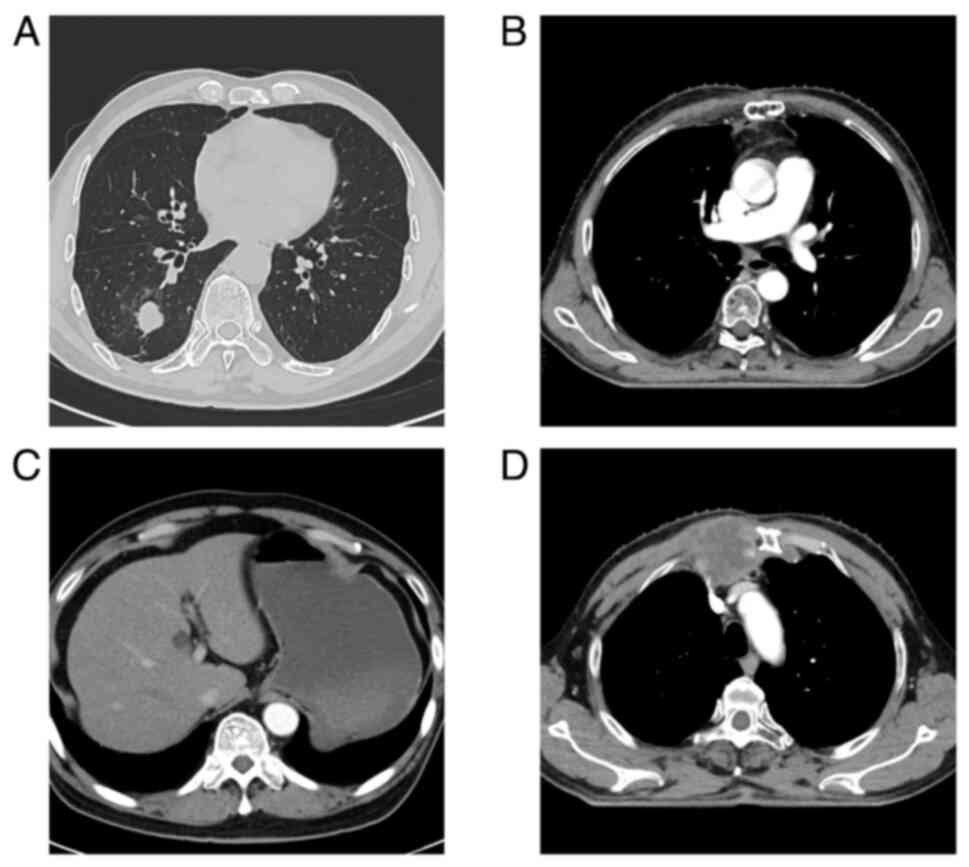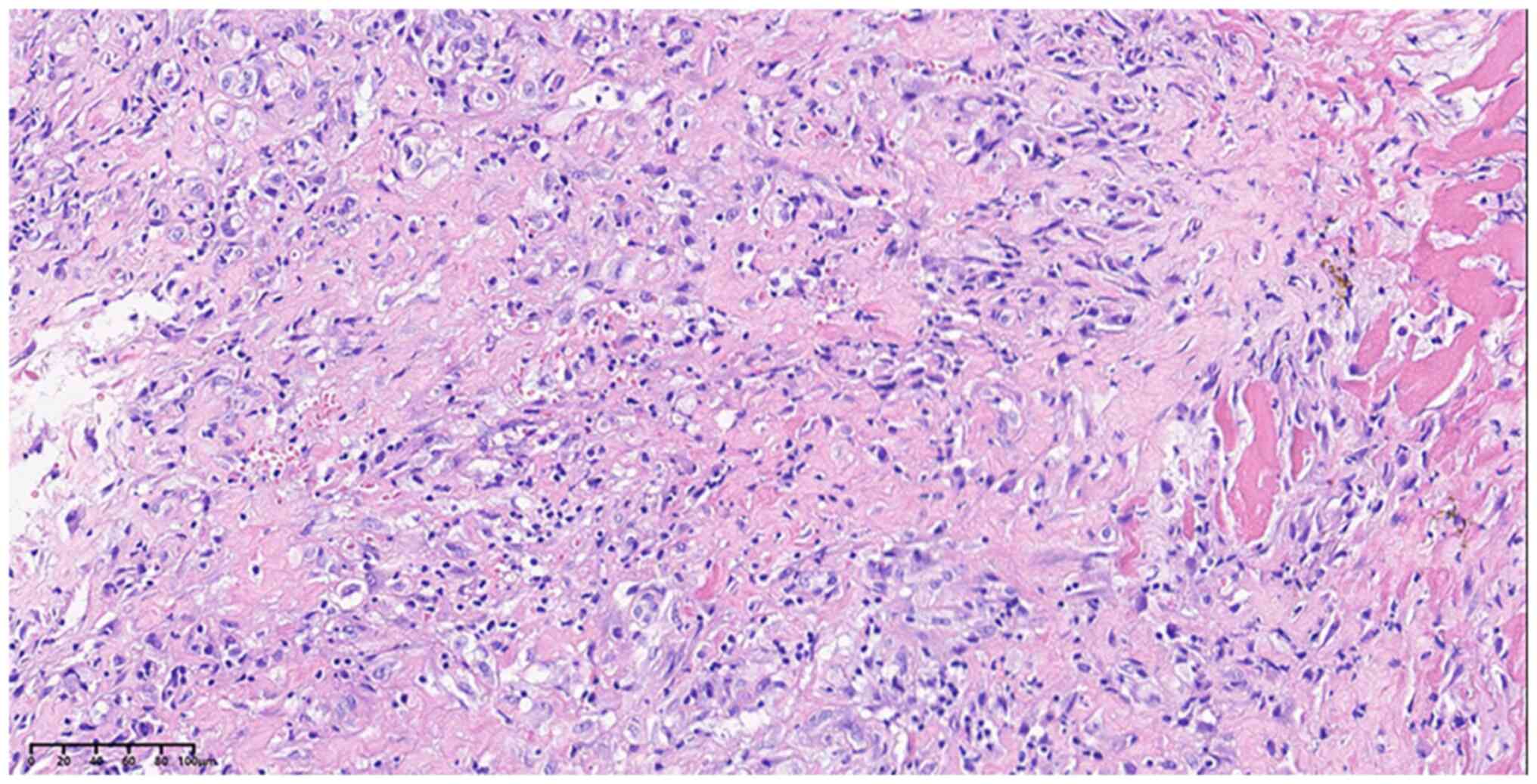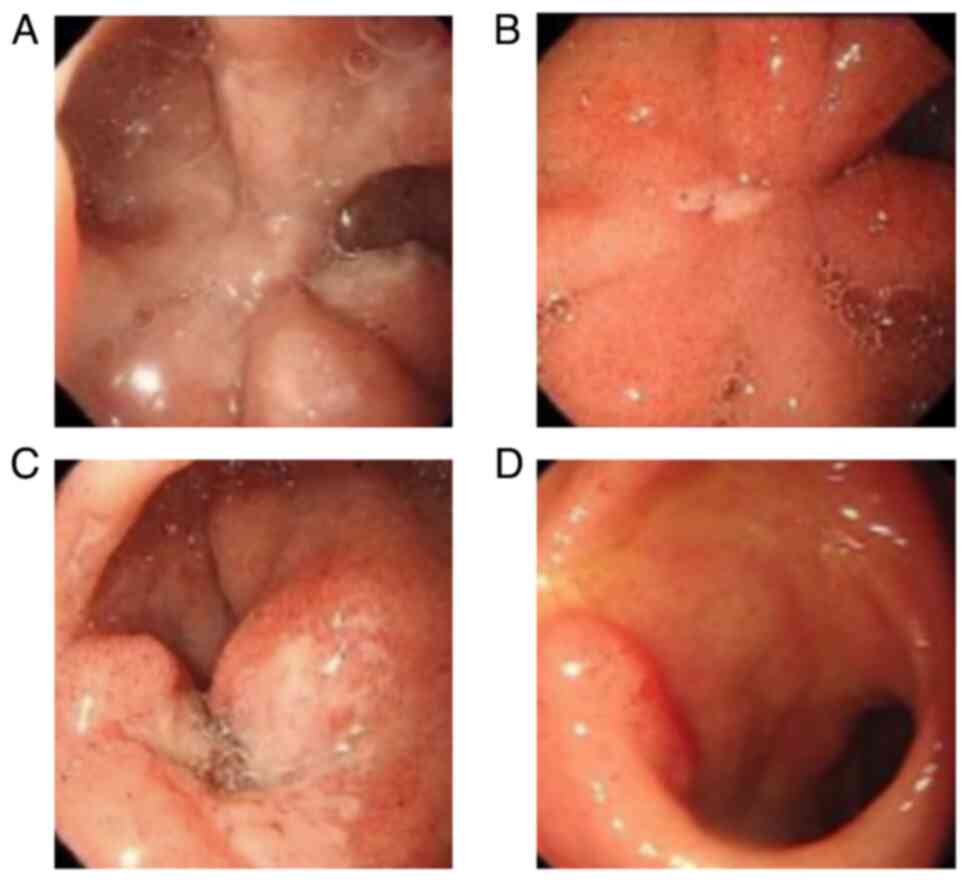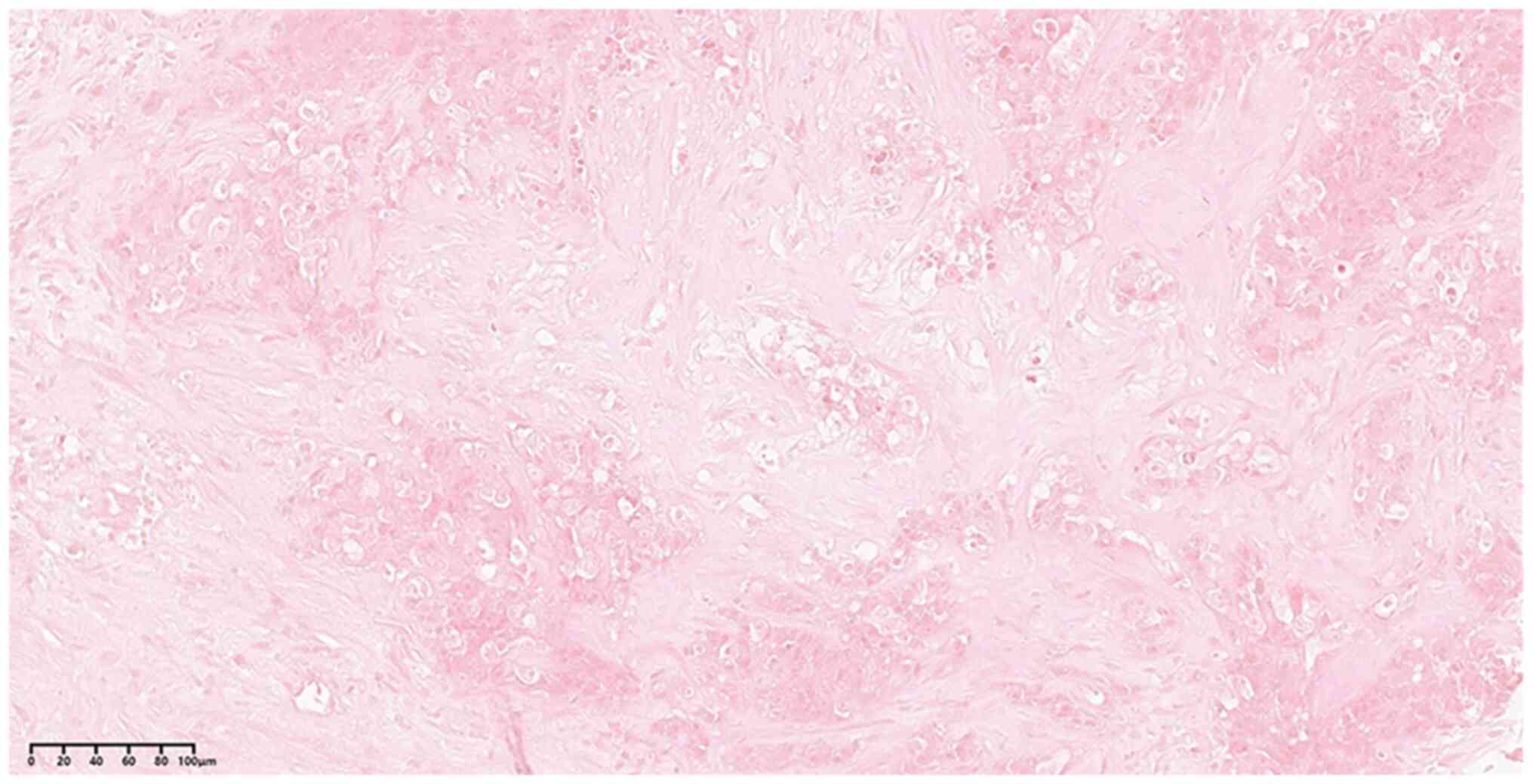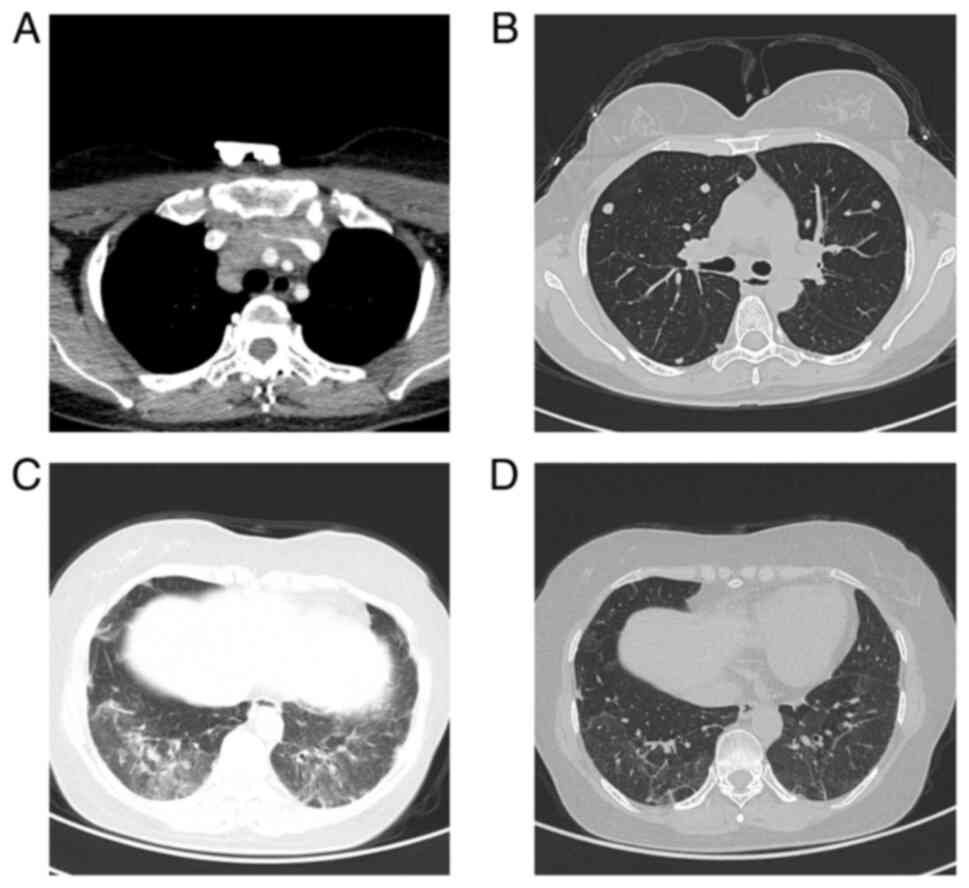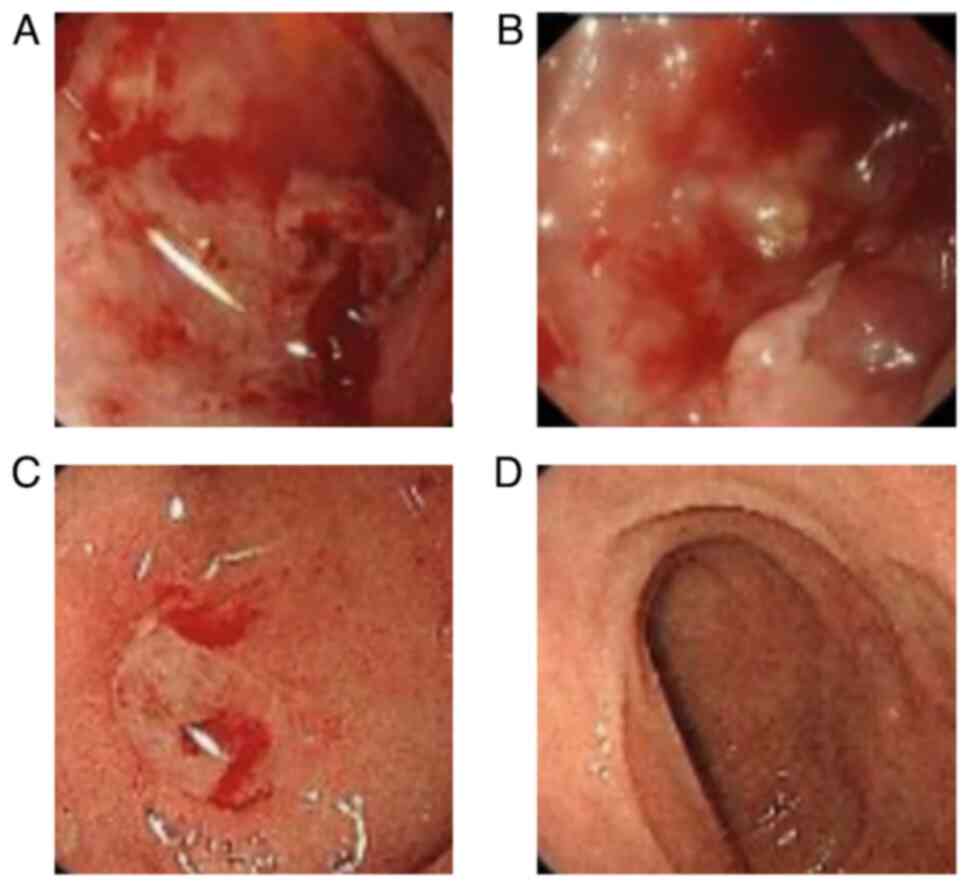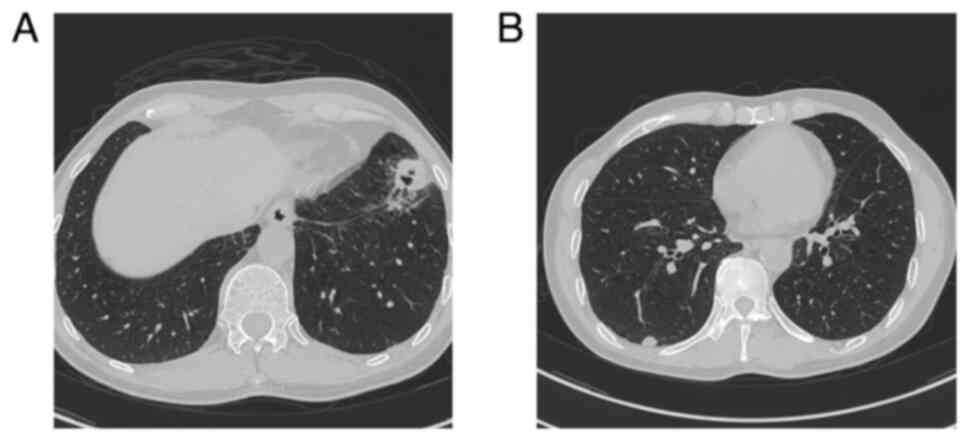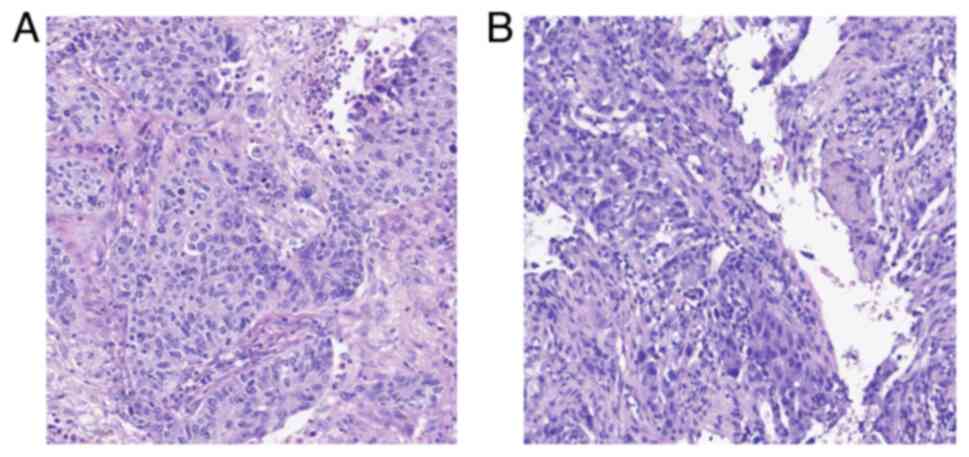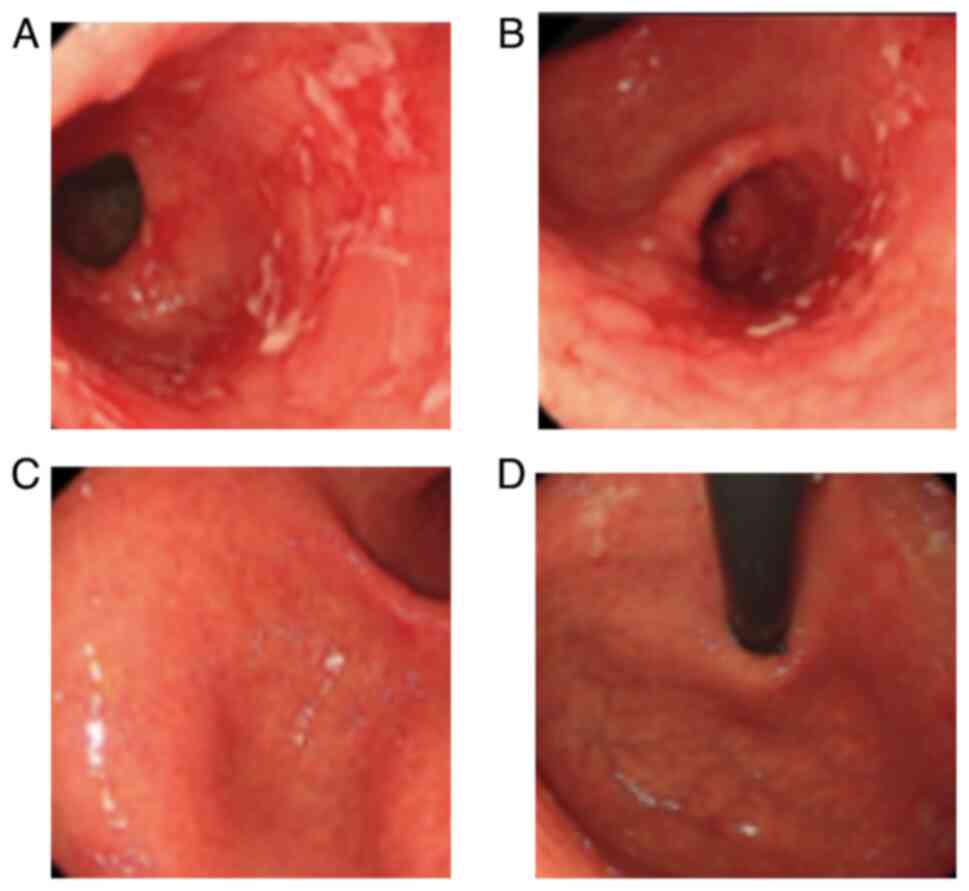Peptic ulcer induced by immune checkpoint inhibitors successfully treated with glucocorticoids: A report of three cases and a literature review
- Authors:
- Published online on: August 28, 2024 https://doi.org/10.3892/etm.2024.12699
- Article Number: 410
-
Copyright: © Wang et al. This is an open access article distributed under the terms of Creative Commons Attribution License.
Abstract
Introduction
Among the numerous novel immunotherapies, immune checkpoint inhibitors (ICIs) have emerged as critical treatments for cancer. The two most studied ICIs, cytotoxic T lymphocyte-associated antigen 4 (CTLA-4) and programmed cell death protein 1 (PD-1), serve roles in maintaining the balance between peripheral tolerance and immune response under normal conditions as co-inhibitory molecules to prevent over-activation of immune system (1). Since the initial approval of nivolumab and pembrolizumab by the U.S. Food and Drug Administration, a number of ICIs have been approved in China such as: PD-1 monoclonal antibodies (mAbs) including nivolumab, pembrolizumab, tislelizumab, sintilimab, camrelizumab, toripalimab, penpulimab, zimberelimab and serplulimab; programmed cell death 1 ligand 1 mAbs including durvalumab, atezolizumab and envafolimab; and CTLA-4 mAbs including ipilimumab. The occurrence of immune-related adverse events (irAEs) is linked to overactivation of the immune system, which leads to changes in T-cell activity and cytokine responses (2). It is theorized that there are several mechanisms behind the development of irAEs, including the presence of identical antigens in both tumour and normal tissues, the activation of pre-existing humoral autoimmunity in patients, heightened expression of the CTLA-4 antigen in normal tissues, other genetic factors and the microbiota (3). Higher infiltration of CD4+ T cells is reportedly more usually a result of anti-CTLA-4 therapy, while CD8+ T cells are a result of anti-PD-1 therapy (4).
In general, irAEs occur more frequently in the dermatological, gastrointestinal (GI) and endocrine systems, with GI tract irAEs accounting for 30-50% of all irAEs (2,5). Most GI adverse events typically occur within 3 months of treatment initiation. The incidence of GI toxicity is particularly high during combination therapy with nivolumab and ipilimumab (6). Typical irAEs in the digestive system include immune-mediated colitis (8-22%), hepatotoxicity (4-11%), pancreatitis (10-15%) and non-specific symptoms such as nausea, vomiting and diarrhoea (27-54%) (2). However, toxicities affecting the upper GI tract, particularly peptic ulcers, have rarely been reported.
The treatment choice for GI irAEs depends on the specific disease presentation (7). Supportive treatments such as anti-motility agents (including atropine/diphenoxylate and loperamide) and dietary adjustments (including low-fibre and bland diets) are recommended for grade 1 GI irAEs. In cases of grade 2 GI irAEs, it is crucial to rule out infectious factors, and systemic corticosteroids (including prednisone/intravenous methylprednisolone at 1-2 mg/kg/day) should be initiated until symptoms improve to grade 1 or lower (8,9). After the improvement of adverse events, it is recommended to discontinue anti-CTLA-4 agents permanently. Whether anti-PD-1 agents can be resumed depends on their previous efficacy (10,11). For grade 3-4 toxicities, administration of ICIs should be immediately and permanently halted (10-13). Alongside intravenous methylprednisolone, maintaining electrolyte balance and implementing aggressive fluid resuscitation are required for the management of grade 3-4 toxicities. These strategies have been reported to lead to the regression of GI irAEs in 40-70% of patients (14). For patients experiencing grade 2-4 toxicities, it is essential to assess response to corticosteroid treatment after 3 days of administration to promptly identify patients with a poor response. In cases where corticosteroids are ineffective, additional treatment options include biological agents, such as infliximab and vedolizumab, should be considered (15).
In the present case series, the diagnosis and treatment of 3 patients with ICI-induced peptic ulcers at West China Hospital (Chengdu, China) is presented. All patients were diagnosed by GI endoscopy and treated with corticosteroids. Patient follow-up was performed through outpatient visits or telephone calls.
Case report
Materials and methods
The cancer tissue used was fixed with 4% paraformaldehyde at 25˚C for 24 h and embedded with paraffin. Embedded tissue was cut into 5 µm sections. Then the slides were stained by hematoxylin for 5 min and eosin for 25 sec at 25˚C. The stained slides were observed under light microscope.
Patient 1. In October 2018, a 60-year-old man presented with a mass in the lower lobe of the right lung on CT scan (Fig. 1A) at West China Hospital (Chengdu, China). The patient underwent thoracoscopic right lower pneumonectomy. The pathological result suggested non-keratinised squamous cell carcinoma [pT1cN0M0; stage IA3, AJCC 8th edition (16)] (Fig. 2). At 1 year post surgery, a mediastinal metastasis was discovered (Fig. 1B), prompting the administration of three cycles of chemotherapy (paclitaxel albumin 440 mg every 21 days and carboplatin 400 mg/21 days), with immunotherapy (pembrolizumab 200 mg every 21 days). Subsequently, the patient received seven cycles of pembrolizumab (200 mg every 21 days) as maintenance therapy. After the third cycle of maintenance therapy, anlotinib hydrochloride (12 mg, days 1-14, every 21 days) was introduced due to tumour progression. Subsequently, the patient underwent incomplete excision of the mediastinal metastasis followed by concurrent chemoradiotherapy (paclitaxel albumin 400 mg every 21 days and carboplatin 380 mg every 21 days, with radiotherapy administered for cardiophrenic angle lesions at a dose of [45 Gy/25 fractions (f)]. Moreover, Tislelizumab (200 mg every 21 days) was initiated after the second cycle of chemotherapy upon the discovery of liver metastasis (Fig. 1C). The patient underwent a total of five cycles of chemotherapy and six cycles of tislelizumab. Subsequently, sternal metastases were detected (Fig. 1D), leading to sternum radiotherapy (30 Gy/10f), followed by six cycles of paclitaxel albumin (400 mg every 21 days) and tislelizumab (200 mg every 21 days) as maintenance therapy.
After completing the last treatment cycle, the patient reported experiencing abdominal pain. GI endoscopy revealed the presence of a duodenal bulbar ulcer (Fig. 3A). Helicobacter pylori (HP) infection was negative and confirmed via the C14 breath test. Neither non-steroidal anti-inflammatory drugs (NSAIDS) nor steroids were prescribed to the patient, as administration of NSAIDS is also a common cause of peptic ulcer and the treatment is different. Given that other causes besides ICIs were deemed to not explain the duodenal bulbar ulcer, the patient was diagnosed with an ICI-induced duodenal bulbar ulcer. Treatment was initiated with a daily administration of 40 mg methylprednisolone, 40 mg omeprazole and teprenone 50 mg three times daily. After 1 month of treatment, GI endoscopy revealed an improvement in the duodenal bulbar ulcer (Fig. 3B). Then, 1 month later, progression of the right lung metastasis was identified and tislelizumab (200 mg every 21 days) was reintroduced for two cycles. However, the patient experienced shoulder and chest pain and GI endoscopy identified a new duodenal bulbar ulcer (Fig. 3C). Consequently, the patient was treated with a daily administration of 40 mg methylprednisolone and 40 mg omeprazole. Following a 2-month-treatment period, the duodenal ulcer healed (Fig. 3D). Subsequently, the patient was administered oral afatinib (30 mg every day) to control the tumor. The patient was then followed up regularly at West China Hospital for 27 months until October 2023, without disease progression.
Patient 2. A 52-year-old woman presented at West China Hospital with a neck mass in November, 2016. Based on cervical lymph node biopsy (Fig. 4) and CT scans (Fig. 5A and B), the patient was diagnosed with thymic squamous cell carcinoma with cervical lymph node and lung metastasis [cT3N2M1; stage IV, AJCC 8th edition (16)]. The patient underwent five cycles of chemotherapy (gemcitabine 1,600 mg every 21 days and cisplatin 40 mg days 1-3 every 21 days), resulting in partial remission (PR), as determined by CT scan. Following chemotherapy, the patient received apatinib (750 mg every day) as a maintenance therapy for 10 days. However, the patient experienced symptoms of headache, fatigue and albuminuria, leading to the discontinuation of apatinib. After 2 months, CT scan showed that the tumor was larger than before. Then, the patient underwent six cycles of paclitaxel (320 mg every 21 days) and carboplatin (600 mg every 21 days). Subsequently, the patient was treated with sunitinib (37.5 mg every day). However, due to intolerance to its side effects, the treatment was changed to 27 cycles of pembrolizumab (200 mg every 21 days). After the sixth cycle, the patient was diagnosed with ICI-related pneumonia (Fig. 5C and D). This condition was successfully treated with a 40-day course of prednisone (50 mg every day). Moreover, the patient received radiotherapy for the supraclavicular and mediastinal lymph nodes (5,040 cGy/28f). After completing 27 cycles of pembrolizumab (200 mg every 21 days), the patient developed nausea, vomiting, melena and upper abdominal discomfort. The subsequent HP test was positive and GI endoscopy revealed a duodenal bulbar ulcer (Fig. 6A). Consequently, the patient was diagnosed with an HP infection and anti-HP therapy was initiated (amoxicillin 1,000 mg twice every day, levofloxacin 500 mg once every day, bismuth potassium cirtrate 300 mg 4 times every day, omeprazole 40 mg once every day). However, despite 4-week-treatment, the symptoms and the duodenal bulbar ulcers persisted (Fig. 6B). Given that neither NSAIDS nor steroids were prescribed and the stool test for parasitic and bacterial infection showed negative results, the patient was diagnosed with an ICI-induced duodenal bulbar ulcer. After 3 days of 40 mg methylprednisolone treatment daily, the symptoms subsided and the duodenal bulbar ulcer was successfully healed, as confirmed by the GI endoscopy results (Fig. 6C and D). The patient was followed up regularly thereafter for 52 months until March, 2023 with no disease progression.
Patient 3. A 68-year-old man presented at West China Hospital with persistent cough and sputum production in April, 2020. A CT scan identified a bilateral lung mass (Fig. 7). The patient was diagnosed with poorly differentiated squamous carcinoma of the upper lobe of the left lung via bronchofiberscopy biopsy (Fig. 8A) and poorly differentiated adenocarcinoma of the lower lobe of the left lung through percutaneous lung needle biopsy (Fig. 8B). The patient underwent six cycles of pemetrexed disodium (860 mg every 21 days) and carboplatin (475 mg every 21 days) in combination with pembrolizumab (200 mg every 21 days), followed by five cycles of pemetrexed disodium (860 mg every 21 days) and pembrolizumab (200 mg every 21 days) as maintenance therapy. Throughout the treatment process, the CT scan consistently indicated PR. Due to the slight enlargement of the pleural nodule, the patient received local radiotherapy (24 Gy/3f). After 31 cycles of maintenance therapy, the patient reported upper abdominal pain, hiccups and weight loss. Despite a 2-month administration of omeprazole (40 mg every day), the symptoms persisted, and GI endoscopy identified a gastric ulcer (Fig. 9A and B). Neither NSAIDS nor steroids had been prescribed to this patient. Consequently, the patient was diagnosed with an ICI-induced gastric ulcer and was treated with dexamethasone (11.25 mg every day). After 1 month, the patient reported that the discomfort had subsided, and GI endoscopy confirmed the disappearance of the gastric ulcer (Fig. 9C and D). Subsequently, the patient was followed up for 18 months until March, 2024 and demonstrated consistent PR.
Discussion
With the increasing utilization of ICIs, irAEs have become more prevalent and have garnered heightened attention. However, upper immunotherapy-related upper GI ulcers are rare and there is currently no established standard treatment. Previously reported cases are summarised in Table I, in which 6 reported cases of ICI-induced peptic ulcers are listed. Among them, 3 patients received glucocorticoids and experienced symptomatic relief. The symptoms of 2 patients improved after receiving infliximab therapy. However, 1 patient succumbed to gastric ulcer perforation, despite receiving dexamethasone treatment. Initially, this patient was diagnosed with NSAIDS-related gastric ulcers due to recent daily NSAIDS use, highlighting the importance of timely diagnosis of ICI-induced peptic ulcers.
Peptic ulcers can be induced by numerous factors, including ICIs, radiotherapy, anti-angiogenesis-targeting drugs, NSAIDS, steroids, HP infection, bacteria and parasites. Early diagnosis of ICI-induced peptic ulcers is crucial as treatment approaches for peptic ulcers vary depending on the underlying cause. Usually, peptic ulcers may necessitate acid suppression and stomach protection treatment. Ulcers induced by other drugs require immediate discontinuation of the responsible medication followed by acid suppression and stomach protection therapy. Ulcers caused by pathogens require identification of the specific etiology and targeted treatment. For instance, HP-related ulcers typically require standard anti-HP therapy (17). Due to the unique mechanisms of ICIs, ICI-induced ulcers require not only anti-acid treatment but also prompt initiation of immunosuppressive therapy. Some immunosuppressants, such as corticosteroids, are contraindicated in ulcers caused by other factors, as they may cause secondary ulcers. Compared with irAEs affecting other systems, initial symptoms of irAEs affecting the digestive system, such as nausea, vomiting and anaemia, may not be typical. This complexity arises from the medical history of the patient with the symptoms often being mistaken for chemotherapy side effects. Hence, the careful consideration and differential diagnosis of ICI-induced ulcers pose challenges and necessitates the extensive experience of the clinicians, attentive listening to complaints from patients and thorough knowledge of their medical history (18). In the present case series, it is noteworthy that the 3 patients had not been previously exposed to NSAIDs or steroids and stool test for enteric bacterial and parasitic infections were negative. Moreover, the radiotherapy fields of these 3 patients were distant from the GI tract. Despite the positive HP test result for patient 2, the lesion and symptoms did not ameliorate following anti-HP therapy. Notably, patient 2 had previously received anti-angiogenetic drugs, but the onset of the duodenal bulbar ulcers occurred over a year after the administration of these drugs and are therefore likely unrelated. Standard peptic ulcer treatments, including acid inhibitory drugs, anti-motility agents and dietary adjustments, failed to yield improvement for all 3 patients. Consequently, all 3 patients were diagnosed with ICI-induced upper GI ulcers.
The positive aspect of GI irAEs is their relationship with longer overall survival times (OS) compared with those without GI toxicity (19,20). Moreover, previous study reported that high grade of diarrhoea was associated with improved OS times (P=0.04). Similarly, patients who experienced serious or recurrent irAEs exhibited longer OS times compared with those with mild symptoms (28.5 vs. 13 months; P=0.015) (21). Furthermore, patients who encounter two simultaneous or sequential irAEs may have more favourable clinical outcomes. For instance, patients experiencing both colitis and a rash caused by immunotherapy had a significantly improved OS time (28.6 vs. 19.9 months; P=0.018) and progression-free survival time (16.1 vs. 3.2 months; P=0.001) compared with those with colitis alone (22). The specific mechanisms underlying irAEs and their prognoses remain elusive. However, previous research indicates that interleukin 6 (IL-6) might serve a role in elucidating the connection between irAEs and patient prognosis. A previous study compared the RNA expression in colonic tissues from patients with ICI-induced colitis and paired normal colonic tissue, including patients ‘responding’ and ‘not-responding’ to ipilimumab treatment, and it was reported that IL-6 expression was upregulated in inflamed colon tissue (23). Moreover, increased IL-6 expression was reported in patient with ‘non-responding’ tumours compared with patient with ‘responding’ tumours. IL-6 is a cytokine involved in the differentiation of naïve CD4+ T cells into the T helper 17 (Th17) cell lineage, which serves a role in the pathogenesis of several autoimmune diseases, such as systemic lupus erythematosus and giant cell arteritis (24). A prospective study of 140 patients indicated that a lower baseline IL-6 serum level was an independent risk factor for irAEs (odds ratio=2.84; 95% confidence interval, 1.34-6.03; P=0.007) (25). A previous study indicated that blocking IL-6 expression was associated with decreased tumour size, a higher density of CD4+/CD8+ effector T cells and reduced infiltration of Th17 cells, macrophages and myeloid cells in murine models (26). Furthermore, a retrospective study that analysed 92 patients who received therapeutic anti-IL-6R antibodies (tocilizumab or sarilumab) indicated that IL-6 blockade may be a promising method to treat a number of irAEs without reducing antitumour immunity (27). In addition, two phase II clinical studies assessing the safety and efficacy of tocilizumab in combination with ICIs are ongoing (NCT04940299 and NCT03999749).
The present case series only discussed 3 patients with ICI-induced peptic ulcers and did not further evaluate the mechanisms underlying ulcer development, indicating certain limitations of the study. However, ICI-induced peptic ulcers are relatively rare among GI irAEs and are not easily identified at an early stage. In the present study, all 3 patients were diagnosed at an early stage and demonstrated improvement after treatment, without any effect on treatment efficacy of tumor. This aspect of the present study provides some level of innovation.
By reporting these cases, the aim of the present case series was to contribute to the knowledge base and provide valuable insights for other physicians involved in the diagnosis and treatment of peptic ulcers. Similar literature reports and listed symptoms, treatment methods and prognosis were also summarised to collate the relevant information in the literature. In the present study, 3 patients diagnosed with ICI-induced peptic ulcers through GI endoscopy effectively treated with corticosteroids are presented. Peptic ulcer is a rare adverse event of ICI and can lead to serious complications, underscoring the importance of early diagnosis, accurate assessment and timely intervention.
Acknowledgements
Not applicable.
Funding
Funding: No funding was received.
Availability of data and materials
The data generated in the present study may be requested from the corresponding author.
Author's contributions
Conceptualisation, supervision and project administration were performed by SZ. Methodology, resources and data curation were performed by MY. Investigation, data validation and visualization were performed by QW. The manuscript draft was prepared by QW and edited by SZ. QW and MY confirm the authenticity of all the raw data. All authors read and approved the final version of the manuscript.
Ethics approval and consent to participate
Not applicable.
Patient consent for publication
Informed consent for treatment information and results of examination were obtained from all participants involved in the study. Written informed consent was obtained from the patients for the publication of this article.
Competing interests
The authors declare that they have no competing interests.
References
|
Pardoll DM: The blockade of immune checkpoints in cancer immunotherapy. Nat Rev Cancer. 12:252–264. 2012.PubMed/NCBI View Article : Google Scholar | |
|
Som A, Mandaliya R, Alsaadi D, Farshidpour M, Charabaty A, Malhotra N and Mattar MC: Immune checkpoint inhibitor-induced colitis: A comprehensive review. World J Clin Cases. 7:405–418. 2019.PubMed/NCBI View Article : Google Scholar | |
|
Durrechou Q, Domblides C, Sionneau B, Lefort F, Quivy A, Ravaud A, Gross-Goupil M and Daste A: Management of immune checkpoint inhibitor toxicities. Cancer Manag Res. 12:9139–9158. 2020.PubMed/NCBI View Article : Google Scholar | |
|
Coutzac C, Adam J, Soularue E, Collins M, Racine A, Mussini C, Boselli L, Kamsukom N, Mateus C and Charrier M: Colon immune-related adverse events: Anti-CTLA-4 and Anti-PD-1 blockade induce distinct immunopathological entities. J Crohns Colitis. 11:1238–1246. 2017.PubMed/NCBI View Article : Google Scholar | |
|
Darnell EP, Mooradian MJ, Baruch EN, Yilmaz M and Reynolds KL: Immune-related adverse events (irAEs): Diagnosis, management, and clinical pearls. Curr Oncol Rep. 22(39)2020.PubMed/NCBI View Article : Google Scholar | |
|
Shieh C, Chalikonda D, Block P, Shinn B and Kistler CA: Gastrointestinal toxicities of immune checkpoint inhibitors: A multicenter retrospective analysis. Ann Gastroenterol. 34:46–52. 2021.PubMed/NCBI View Article : Google Scholar | |
|
Thompson JA, Schneider BJ, Brahmer J, Andrews S, Armand P, Bhatia S, Budde LE, Costa L, Davies M, Dunnington D, et al: Management of immunotherapy-related toxicities, version 1.2019. J Natl Compr Canc Netw. 17:255–289. 2019.PubMed/NCBI View Article : Google Scholar | |
|
Pernot S, Ramtohul T and Taieb J: Checkpoint inhibitors and gastrointestinal immune-related adverse events. Curr Opin Oncol. 28:264–268. 2016.PubMed/NCBI View Article : Google Scholar | |
|
Kähler KC, Hassel JC, Heinzerling L, Loquai C, Mössner R, Ugurel S, Zimmer L and Gutzmer R: ‘Cutaneous Side Effects’ Committee of the Work Group Dermatological Oncology (ADO). Management of side effects of immune checkpoint blockade by anti-CTLA-4 and anti-PD-1 antibodies in metastatic melanoma. J Dtsch Dermatol Ges. 14:662–681. 2016.PubMed/NCBI View Article : Google Scholar | |
|
Brahmer JR, Lacchetti C, Schneider BJ, Atkins MB, Brassil KJ, Caterino JM, Chau I, Ernstoff MS, Gardner JM, Ginex P, et al: Management of immune-related adverse events in patients treated with immune checkpoint inhibitor therapy: American society of clinical oncology clinical practice guideline. J Clin Oncol. 36:1714–1768. 2018.PubMed/NCBI View Article : Google Scholar | |
|
Puzanov I, Diab A, Abdallah K, Bingham CO III, Brogdon C, Dadu R, Hamad L, Kim S, Lacouture ME, LeBoeuf NR, et al: Managing toxicities associated with immune checkpoint inhibitors: Consensus recommendations from the society for immunotherapy of cancer (SITC) toxicity management working group. J Immunother Cancer. 5(95)2017.PubMed/NCBI View Article : Google Scholar | |
|
Haanen J, Carbonnel F, Robert C, Kerr KM, Peters S, Larkin J and Jordan K: ESMO Guidelines Committee. Management of toxicities from immunotherapy: ESMO clinical practice guidelines for diagnosis, treatment and follow-up. Ann Oncol. 28 (Suppl 4):iv119–iv142. 2017.PubMed/NCBI View Article : Google Scholar | |
|
Grover S, Rahma OE, Hashemi N and Lim RM: Gastrointestinal and hepatic toxicities of checkpoint inhibitors: Algorithms for management. Am Soc Clin Oncol Educ Book. 38:13–19. 2018.PubMed/NCBI View Article : Google Scholar | |
|
Collins M, Soularue E, Marthey L and Carbonnel F: Management of patients with immune checkpoint inhibitor-induced enterocolitis: A systematic review. Clin Gastroenterol Hepatol. 18:1393–1403.e1. 2020.PubMed/NCBI View Article : Google Scholar | |
|
Dougan M, Wang Y, Rubio-Tapia A and Lim JK: AGA clinical practice update on diagnosis and management of immune checkpoint inhibitor colitis and hepatitis: Expert review. Gastroenterology. 160:1384–1393. 2021.PubMed/NCBI View Article : Google Scholar | |
|
American Joint Committee on Cancer (AJCC): AJCC Cancer Staging Manual. 8th edition. Springer, Cham, p1032, 2017. | |
|
Kamada T, Satoh K, Itoh T, Ito M, Iwamoto J, Okimoto T, Kanno T, Sugimoto M, Chiba T, Nomura S, et al: Evidence-based clinical practice guidelines for peptic ulcer disease 2020. J Gastroenterol. 56:303–322. 2021.PubMed/NCBI View Article : Google Scholar | |
|
Cheng Y, Ling F, Li J, Chen Y, Xu M, Li S and Zhu L: An updated review of gastrointestinal toxicity induced by PD-1 inhibitors: From mechanisms to management. Front Immunol. 14(1190850)2023.PubMed/NCBI View Article : Google Scholar | |
|
Abu-Sbeih H, Ali FS, Qiao W, Lu Y, Patel S, Diab A and Wang Y: Immune checkpoint inhibitor-induced colitis as a predictor of survival in metastatic melanoma. Cancer Immunol Immunother. 68:553–561. 2019.PubMed/NCBI View Article : Google Scholar | |
|
Wang Y, Abu-Sbeih H, Mao E, Ali N, Ali FS, Qiao W, Lum P, Raju G, Shuttlesworth G, Stroehlein J and Diab A: Immune-checkpoint inhibitor-induced diarrhea and colitis in patients with advanced malignancies: Retrospective review at MD Anderson. J Immunother Cancer. 6(37)2018.PubMed/NCBI View Article : Google Scholar | |
|
Tang L, Wang J, Lin N, Zhou Y, He W, Liu J and Ma X: Immune checkpoint inhibitor-associated colitis: From mechanism to management. Front Immunol. 12(800879)2021.PubMed/NCBI View Article : Google Scholar | |
|
Molina GE, Allen IM, Hughes MS, Zubiri L, Lee H, Mooradian MJ, Reynolds KL, Dougan M and Chen ST: Prognostic implications of co-occurring dermatologic and gastrointestinal toxicity from immune checkpoint inhibition therapy for advanced malignancies: A retrospective cohort study. J Am Acad Dermatol. 82:743–746. 2020.PubMed/NCBI View Article : Google Scholar | |
|
Johnson DH, Hailemichael Y, Foo WC, Hess KR, Haymaker CL, Wani KM, Lazar AJ, Saberian CM, Bentebibel SE, Burton EM, et al: Interleukin-6 is potential target to de-couple checkpoint inhibitor-induced colitis from antitumor immunity. J Clin Oncol. 37(2616)2019. | |
|
Miossec P, Korn T and Kuchroo VK: Interleukin-17 and type 17 helper T cells. N Engl J Med. 361:888–898. 2009.PubMed/NCBI View Article : Google Scholar | |
|
Valpione S, Pasquali S, Campana LG, Piccin L, Mocellin S, Pigozzo J and Chiarion-Sileni V: Sex and interleukin-6 are prognostic factors for autoimmune toxicity following treatment with anti-CTLA4 blockade. J Transl Med. 16(94)2018.PubMed/NCBI View Article : Google Scholar | |
|
Hailemichael Y, Johnson DH, Abdel-Wahab N, Foo WC, Bentebibel SE, Daher M, Haymaker C, Wani K, Saberian C, Ogata D, et al: Interleukin-6 blockade abrogates immunotherapy toxicity and promotes tumor immunity. Cancer Cell. 40:509–523.e6. 2022.PubMed/NCBI View Article : Google Scholar | |
|
Fa'ak F, Buni M, Falohun A, Lu H, Song J, Johnson DH, Zobniw CM, Trinh VA, Awiwi MO, Tahon NH, et al: Selective immune suppression using interleukin-6 receptor inhibitors for management of immune-related adverse events. J Immunother Cancer. 11(e006814)2023.PubMed/NCBI View Article : Google Scholar | |
|
Young K, Lin E, Chen E, Brinkerhoff B, Scott G and Yu J: Small bowel hemorrhage from check point inhibitor enteritis: A case report. BMC Gastroenterol. 21(345)2021.PubMed/NCBI View Article : Google Scholar | |
|
Trystram N, Laly P, Bertheau P, Baroudjian B, Aparicio T and Gornet JM: Haemorrhagic shock secondary to a diffuse ulcerative enteritis after Ipilimumab and Nivolumab treatment for metastatic melanoma: A case report. Ann Palliat Med. 11:837–842. 2022.PubMed/NCBI View Article : Google Scholar | |
|
Liu WT, Li YF and Hsieh TY: Unusual severe gastritis and gastric ulcers caused by pembrolizumab. J Postgrad Med. 68:38–40. 2022.PubMed/NCBI View Article : Google Scholar | |
|
Kato R, Hayashi H, Sano K, Handa K, Kumode T, Ueda H, Okuno T, Kawakami H, Matsumura I, Kudo M and Nakagawa K: Nivolumab-induced hemophilia A presenting as gastric ulcer bleeding in a patient with NSCLC. J Thorac Oncol. 13:e239–e241. 2018.PubMed/NCBI View Article : Google Scholar | |
|
Desai M, Chitnavis V and Grider D: Gastric ulcer in a patient with metastatic lung cancer. Gastroenterology. 156:1572–1573. 2019.PubMed/NCBI View Article : Google Scholar |



